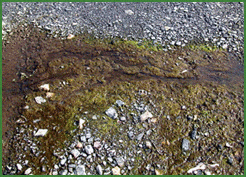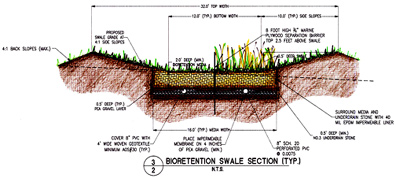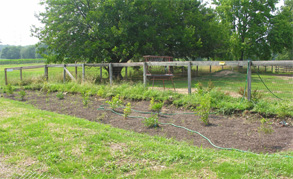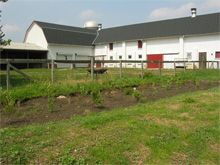|
 Custom
Designed Rain Garden Custom
Designed Rain Garden
Plan of Action for Water Quality
Management
|
 |
|
A proper
water management plan is essential for eliminating standing
water and
the health risks it presents.
|
An effective water management plan will help
minimize the agricultural impact of horse farms on local streams, lakes,
groundwater, and other water sources. It should employ Best Management
Practices (BMPs) wherever possible to prevent clean runoff from becoming
contaminated, minimize the amount of contamination caused by
agricultural operations, and capture and treat contaminated runoff
before it can reach nearby water bodies. As with any plan, careful
monitoring and performance evaluation over time will help determine its
effectiveness, as well as indicate areas where improvement may be
needed.
Elements of a good water quality
management plan would include:
- Runoff controls to direct runoff away from potential
contamination sources such as manure storage areas.
- Piping of relatively clean roof runoff through an infiltration
trench in order to provide as much groundwater recharge as possible.
Flows in excess of infiltration capacity would be routed to a
bioretention basin.
- Routing of drainage
through biofiltration swales to encourage infiltration and provide
initial settling of suspended solids.
- Fences to restrict horses from open water swale areas and
prevent direct contamination.
- Drainage swales protected by riparian vegetative buffers that
act as filter strips to provide initial settling and filtration.
- Bioretention basins
to provide filtration and treatment before discharge to
drainage swales and the environment.
 |
|
Bioswales are landscape
elements designed to remove silt
and pollution from surface runoff water.Swales such as this
one will be installed at the Ryders Lane facility.
Click the image above to open a large version. |
For the purposes of this farm, the flow from
the central biofiltration swale will be split and routed into two calibrated and instrumented swales that can be modified
to compare the performance of various treatment options (soil media,
plants, etc.) on the same runoff. This scientific study will allow
easy-to-implement treatment options to be developed and distributed to
New Jersey’s farm managers through the project’s outreach component.
Information on NJDEP Wetlands Regulations
Below are some resources which
give information on the New Jersey Department of
Environmental Protection (NJDEP) regulations that affect
agricultural operations.
NJDEP Water Regulations
(PowerPoint)
(PDF)
Agricultural Impact of Stream Encroachment Rules
Freshwater Wetland Rules and Agriculture
Stormwater Runoff Paddock Drainage System
The Rutgers Cooperative Extension Water Resources Program, in cooperation with the Equine Science Center, designed and installed a new roof drainage system for the paddock area on the southeast corner of the barn at the Ryders Lane Facility.
The work completed at the site consisted of:
 |
|
The
initial trench along south side of the paddock area. Click
for a larger image.
|
- An underground drainage system which was constructed to eliminate
contact between clean roof drainage and water that drains from the
paddock area.
- A drainage system which was constructed to allow rain water to
infiltrate during small storms and drain to a downstream bioretention
basin during larger storms.
The piping system consists of perforated 4”
PVC pipes laid in a 1’ bed of clean ¾” stone. This project has been very
successful in reducing the amount of mud and transport of fecal material
out of the paddock area. It represents a relatively simple, inexpensive
and effective strategy for reducing contaminated runoff and maintaining
the structural quality of a paddock area.
Photos
Drainage trench with horizontal PVC pipes in a bed of 3/4" stone,
including roof leader connections
Dry lot paddock area post-construction
Custom Designed Rain Garden
Rain gardens are gardens specifically
designed to soak up rain water mainly from roofs, but also from
driveways and lawns. In cooperation with the Equine Science Center, the
Rutgers Cooperative Extension Water Resources Program designed and
installed a rain garden for the paddock area on the southeast corner of
the barn at the Ryders Lane Facility. The rain garden will help remove
nutrients that wash through the manure in horse paddocks due to storms.
 |
|
During
dry spells, rain gardens should be watered manually to
maintain
plant growth. Click
for a larger image.
|
|
 |
|
The rain garden will filter the nutrients in water runoff coming through the adjacent horse paddock. Click for a larger image.
|
Our rain garden contains the following plants:
- Sweet pepper bush
- Switchgrass
- Purple coneflower
- Arrow-wood vibernum
- New York aster
- Inkberry Holly
- Winterberry Holly
Learn More About Rain Gardens
Rain Garden Fact Sheet
 |
